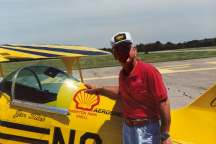 |
|
|
Sopwith Aircraft, Sopwith Camel, Sopwith Pup and Triplane World War 1 Fighter Model Airplanes.
Sopwith Camel World War 1 Airplane section.
of the Prop Fighter Model Department.
in the YellowAirplane store.
|
The Sopwith Camel was perhaps the best Allied fighter of
WWI, successfully downing 1,924 aircraft in only 16 months of fighting. It
was known for being extremely agile and for having a fast rate of climb,
and perhaps most notably, the great Baron von Richthofen fell to the guns
of a 209 Squadron RAF Camel flown by Canadian Roy Brown in 1918. The aviation art section
has some great World War 1 photos and other images. Building
and owning these aircraft will give anyone a good picture of world war
1 history. Sopwith also was famous for the
Sopwith Pup and the British Sopwith Triplane. These Sopwith model airplanes come in 1/20, 1/24, 1/32,
1/48 and 1/72 Scale Pre Built Diecast and Mahogany Display Models and Balsa Wood
and Plastic Model Kits. World War 1 Sopwith Camel Aviation Art and Gifts World War 1 Sopwith Camel Aircraft Models World War 1 Sopwith Camel Books
World War 1
Sopwith Camel Aircraft Models
World War 1 Sopwith Camel Books |
| Jet Fighters | WWII Fighters | WWI Fighters | Guitars | Ships | Spacecraft | Tanks | Trains |
Survival Equipment - Survival Supplies Airplane ArtRail Art 2014 Railroad Calendars
Look Below for More Biplane Pictures and Exhibits
|
|
||||||||||||||||||||||||||||||||||||||||||||||||||||
|
|||||||||||||||||||||||||||||||||||||||||||||||||||||
World
War
1 Fighter Plane Main Index![]()
Typhoon Mosquito
Spitfire British
Fighter Jets British WWI
Aircraft British
Airways
|
The
First Certificated Pitts |
 |
| Aircraft
: Sopwith Camel MANUFACTURER : Sopwith Aviation Co. Ltd. Year : 1917 Engine : 1 x "Bently"BR.1 150 hp / One 130 Clerget 9 cylinder rotary Wingspan : 8.50 m 28ft Length : 5.60 m Weight : 470 kg/695 kg 1,453 lbs Max. speed : 199 km/h 115mph Ceiling : 5650 m 19,000 ft Crew : 1 Armament : 2 x machineguns |
| Research Notes:
Sir Thomas Sopwith The Camel was perhaps the best Allied fighter of WWI, successfully downing 1,924 aircraft in only 16 months of fighting. It was known for being extremely agile and for having a fast rate of climb, and perhaps most notably, the great Baron von Richthofen fell to the guns of a 209 Squadron RAF Camel flown by Canadian Roy Brown in 1918. The Camel had great agility in combat because of the fantastic torque of its rotary engine and because the engine, pilot and guns were all located in the first seven feet of the wooden airframe. No.10 Squadron was formed in February 1917 as part of the rapid naval aviation expansion program on the Western Front. Captain Elliot Springs, 16-victory WWI ace and one of the most colorful American flyers of the war, leads the 148th Aero Squadron. British and Empire Aces of World War I, Shores. While the Allies and their adversaries raced to outdo each other in the creation of genuinely effective fighters in WWI, it was not until 1917 that the British developed a truly effective interrupter gear, paving the way for the Sopwith Camel, S.E.5 and Bristol F.2B. The 17th Aero Squadron in World War I. Reed & Roland. The 17th Aero Squadron flew Sopwith Camels under British command along the Western Front during the summer of 1918. The last of the famous Sopwith fighters to enter service during WWI, the Dolphin and the Snipe built on the strong scouting heritage of the Pup and Camel. The Dolphin, a heavily-armed, negative-staggered-wing biplane, provided the pilot with the best possible tactical view for seeking the enemy. The Snipe succeeded the Camel in August 1918 and proved its superiority over virtually all other fighters. Sopwith Camels, each carrying 250-pound bombs, take to the skies from HMS Furious - the first dedicated aircraft carrier in the world - on a raid against the German Zeppelin sheds at Tondern. Carried out on July 19, 1918, this was the first successful bombing raid ever to be launched from a carrier. The Sopwith Camel is widely recognized as the most successful allied fighter of the Great War. Of the men who flew them exclusively, one name stands out above the rest - Major Donald R. MacLaren, who achieved 54 victories, the final nine of which were scored in this machine. Captain R.A. Little, the RNAS' highest-scoring ace with a total of 47 victories, achieves one of the 15 attained while flying a Sopwith Triplane with No. 8 Squadron RNAS between April and July 1917 The Camel was the most successful fighting scout employed by either side in WWI, responsible for destroying 1,294 enemy aircraft. Requiring highly skilled pilots, many pilots were lost learning to fly the nimble aircraft. The family of Sopwith fighters served England, France and the U.S. throughout World War I, with the 1? Strutter, the Pup, the Camel the Snipe and others becoming classics of the period. Sopwith Pup, the first proper British fighting scout that - though achieving much success after it arrived on the Western front in 1916 - saw its final combat at the end of 1917 when it ceded the skies to the even more famous and successful Sopwith Camel. |
Please Note:
I took the photo of the clouds used in the background picture
while we were
flying from a Northern Siberian city named Khatanga
on our way to
the North Pole in April 2002. C. Jeff Dyrek, webmaster
|
|
|
|
| . |
| . |
Art_Aviation_Art/WorldWar1_Sopwith_Camel_AviationArtGifts.html|19495"
| . |